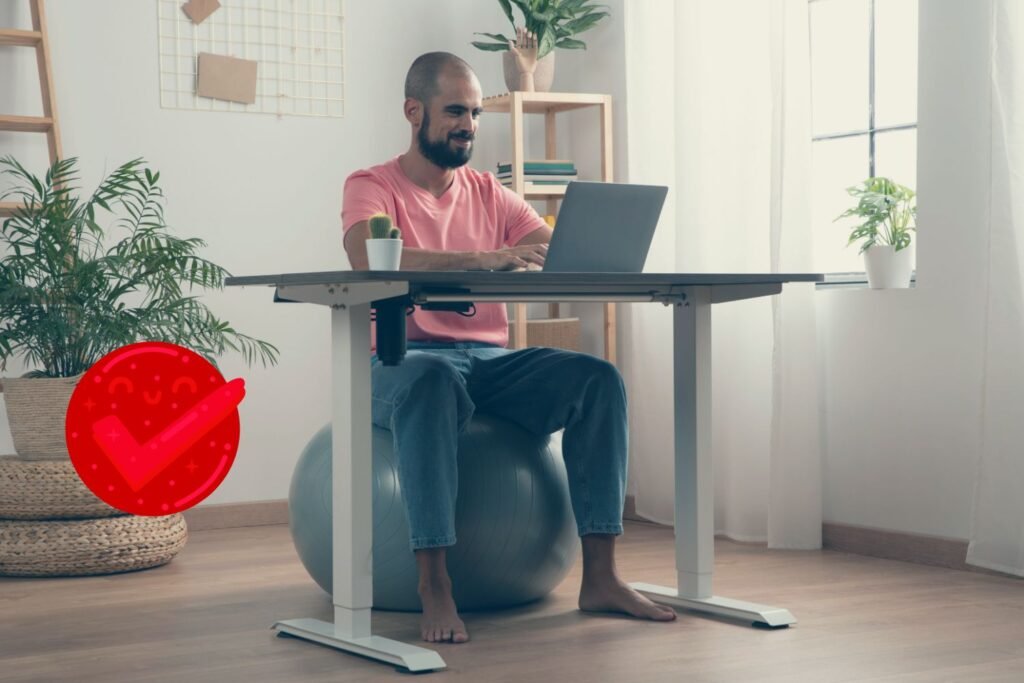Maintaining proper posture while sitting
Introduction:
Sustaining appropriate sitting position is essential for both physical well-being and efficiency. Back pain, decreased mobility, and impaired cognitive function can all be caused by poor posture. This manual offers helpful hints for maintaining good posture, which can reduce pain and improve general health. People can increase their productivity and reduce their chance of developing long-term health problems linked to bad posture by putting these techniques into practice.

Sit with back straight, shoulders relaxed, feet flat, hips aligned, and eyes leveled with the screen.
To fix your posture, use a lumbar support pillow, perform daily stretches, and adjust your workstation ergonomics for optimal alignment and comfort.
Slouched shoulders, rounded spine, and uneven hips are signs of poor posture, often leading to discomfort and health issues.
Understanding Proper Posture:
To reduce the tension on muscles and ligaments, sit with your spine, shoulders, and hips in the proper alignment. Begin with a neutral spine, one that is flexible and retains its natural S-shaped curve. Hips should stay balanced, feet should be flat on the ground or, if necessary, on a footrest, and shoulders should be loose and squared rather than rounded forward.
By distributing weight evenly, a neutral spine lessens pressure points and enhances circulation. Additionally, by improving muscle efficiency, this alignment lessens soreness and weariness. People can enhance their general health and avoid musculoskeletal problems by adopting proper sitting posture. Daily activities that include ergonomic concepts and mindfulness promote long-term health and perpetuate good posture.

Ergonomic Considerations
The configuration of a workstation must take ergonomics into account. To promote healthy circulation and lessen pressure on the legs, start by making sure the chair height permits feet to rest flat on the floor. Proper seat depth promotes balanced weight distribution and avoids pressure spots, and lumbar support preserves the spine’s natural curve to lessen discomfort in the lower back.
Because they may be customized to meet individual needs, adjustable desks and chairs are essential for encouraging proper posture. With their ability to help users achieve the ideal alignment, they minimize strain on muscles and ligaments during the workday and maintain a neutral spine position.

Tips for Maintaining Proper Posture:
Improve posture:
Sit with back straight, shoulders relaxed, feet flat on floor, and chin parallel to ground. Engage core muscles. Take breaks, stretch, and adjust position regularly for comfort and health.
Feet Placement:
Place feet flat on the ground, hip-width apart, with toes pointing forward. Distribute weight evenly. Keep knees at or slightly below hip level for ergonomic support and posture alignment.
Support for Lower Back:
Lumbar support maintains the spine’s natural curve, reducing lower back strain and discomfort for improved comfort and posture while seated.
Position of Arms and Wrists:
Arms and wrists should be positioned parallel to the floor, relaxed, and supported, promoting ergonomic alignment and reducing strain during extended periods of typing or mouse use.
Taking Breaks:
Regular breaks are essential for stretching and readjusting posture, preventing stiffness and fatigue while promoting blood circulation and overall comfort during extended periods of sitting.
Eye Level:
Position computer screens at eye level to alleviate neck strain, promoting a neutral posture and reducing discomfort during prolonged screen use.

Exercises and Stretches:
Provide easy stretches to ease stress and improve posture, such as shoulder shrugs, neck rolls, and seated spinal twists. To guarantee correct execution and optimize benefits, provide links to instructional videos or walk through the exercises. Stretching can help prevent stiffness and increase flexibility, which can enhance general comfort and well-being when sitting for extended periods of time.